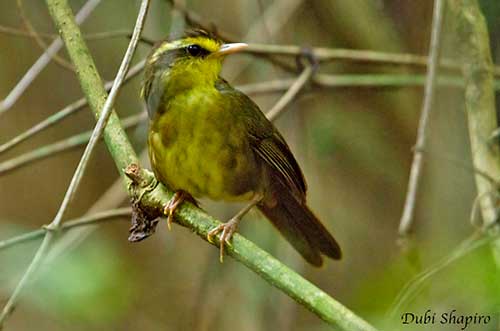
RANGE:
The Madagascan Yellowbrow is found in the eastern rainforest, from Tsaratanana Strict Reserve S to Andohahela National Park.
HABITAT:
The Madagascan Yellowbrow frequents the dense understorey of the rainforest, and usually occurs on the moist ground where it forages actively. It is restricted to mid- and high-elevation forest, and areas with herb layer or bamboo. It is fairly common between 800 and 2,000 metres of elevation.
CALLS AND SONGS: SOUNDS BY XENO-CANTO
The Madagascan Yellowbrow’s call is a thin, penetrating “tsip” given while the bird is moving under the low cover. This call is probably used as contact call, and may sometimes become “tser-sit”.
The song is a series of high-pitched whistled notes “tsit tsit tseer tsee tsit tit”. A quiet, grasshopper-like “shrrrr” is possibly the alarm call. We can also hear a series of high-pitched, thin “tsee tsee tsee” notes.
BEHAVIOUR IN THE WILD:
The Madagascan Yellowbrow feeds on small insects mainly caught on the ground. The bird walks with a rolling gait while foraging actively. It probes in the leaf litter and among the herb layer. It may climb over fallen branches and venture to the low branches of shrubs in the dense understorey. It also collects food items from the overhanging foliage.
The Madagascan Yellowbrow is often seen in pairs or in small family groups of 3-5 individuals, and may join some other bird species. They have been seen climbing up to 3 metres in the vegetation in the evening, probably to reach a roost site.
It also climbs to 1-2 metres up in a shrub to sing or to mob an intruder.
The courtship behaviour is unknown. Both adults build the nest together and they are probably monogamous.
The Madagascan Yellowbrow is apparently sedentary on the island.
The strong legs and feet indicate the terrestrial habits of this species. It prefers to walk or climb rather than to fly or only over short distances.
REPRODUCTION OF THIS SPECIES:
The breeding season takes place between September and December.
The nest is built by both adults, a deep cup made with interwoven moss, grasses or bamboo leaves. The cup is lined with moss. This structure is placed in leaf litter, or in thick liana tangles, or sometimes in shrub, up to 2 metres above the ground.
The female lays at least 3 eggs, and juveniles can be observed between November and January. No more information.
PROTECTION / THREATS / STATUS:
The Madagascan Yellowbrow is threatened by fragmentation and destruction of its habitat, due to deforestation for agriculture and commercial logging.
However, the species occurs in several protected areas where it is common. It is more widely distributed and more common than previously thought.
The Madagascan Yellowbrow is currently listed as Near Threatened.
Fr: Oxylabe à sourcils jaunes - Fouditany à sourcils jaunes
Ang: Madagascan Yellowbrow - Yellow-browed Oxylabes
All: Gelbbrauenfoditany
Esp: Silvícola Foditany
Ita: Oxilabe cigliagialle
Nd: Geelbrauwfoditany
Sd: gulbrynad madagaskarsångare
Mal: Foditany
Photographer:
Dubi Shapiro
Dubi Shapiro Photo Galleries & Dubi Shapiro's Pictures on IBC
Text by Nicole Bouglouan
Sources :
HANDBOOK OF THE BIRDS OF THE WORLD Vol 11 by Josep del Hoyo, Andrew Elliott and David Christie - Lynx Edicions - ISBN: 849655306X
The Birds of Africa: Volume VIII: The Malagasy Region: Madagascar, Seychelles, Comoros, Mascarenes - Par Roger Safford, Frank Hawkins – ISBN: 1408190494, 9781408190494- Editeur: A&C Black, 2013
Birds of Madagascar and the Indian Ocean Islands Par Roger Safford, Adrian Skerrett, Frank Hawkins – ISBN: 1472924118, 9781472924117- Editeur: Bloomsbury Publishing, 2015
Birds of Madagascar: A Photographic Guide Par Pete Morris, Frank Hawkins – ISBN: 0300077556, 9780300077551- Editeur: Yale University Press, 1998
CREAGUS - MALAGASY WARBLERS Bernieridae
Fatbirder - Bernieridae - Malagasy Warblers
Wikipedia, the free encyclopaedia
Madagascan Yellowbrow or Yellow-browed Oxylabes
Crossleyia xanthophrys
Passeriformes Order – Bernieridae Family
INTRODUCTION:
The Madagascan Yellowbrow is endemic to Madagascar and occurs in the eastern rainforest. This terrestrial warbler is often seen walking on moist ground in the dense understorey while foraging.
This species is now part of the independent Malagasy radiation and of the family Bernieridae, following several changes. It was formerly placed in the family Sylviidae of the Old World warblers. It is the sole member of the genus Crossleyia.
The Madagascan Yellowbrow is threatened by reduction and fragmentation of the habitat through deforestation for agriculture expansion and commercial logging. It is currently listed as Near Threatened.
DESCRIPTION OF THE BIRD:
Biometrics:
Length: 15 cm
Weight: 15-22 g
The Madagascan Yellowbrow has dark olive-green crown, nape, mantle and back. The top of the head contrasts with the conspicuous yellow supercilium extending from lores to behind the eye where it is paler. Wings and tail are mostly olive-brown with darker uppertail.
On the underparts, chin, throat and upper breast are yellow with olive wash. The lower breast is yellow-olive, becoming darker on belly and undertail-coverts.
The short bill is pale pink. The eyes are dark brown. The strong legs and feet are dull pink.
Male and female are similar.
The juvenile is duller than adults on supercilium and breast. The bill has dark brown culmen and bill tip.
